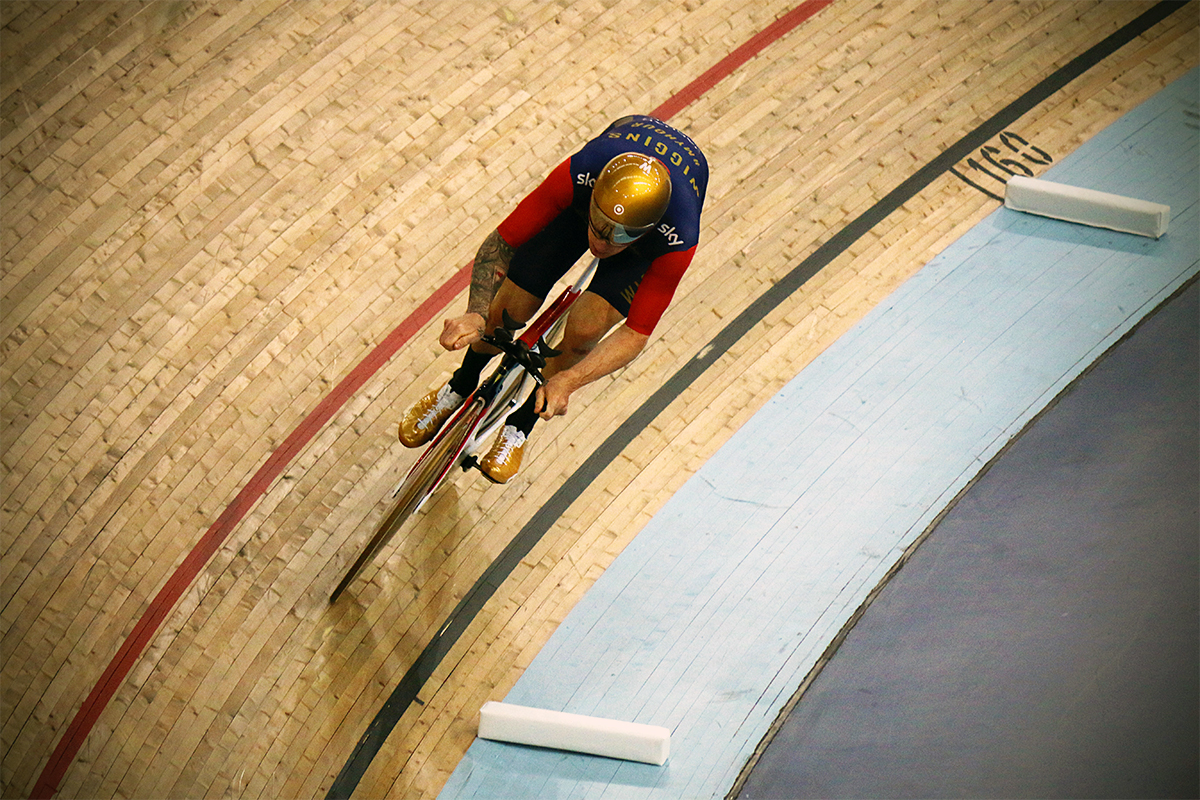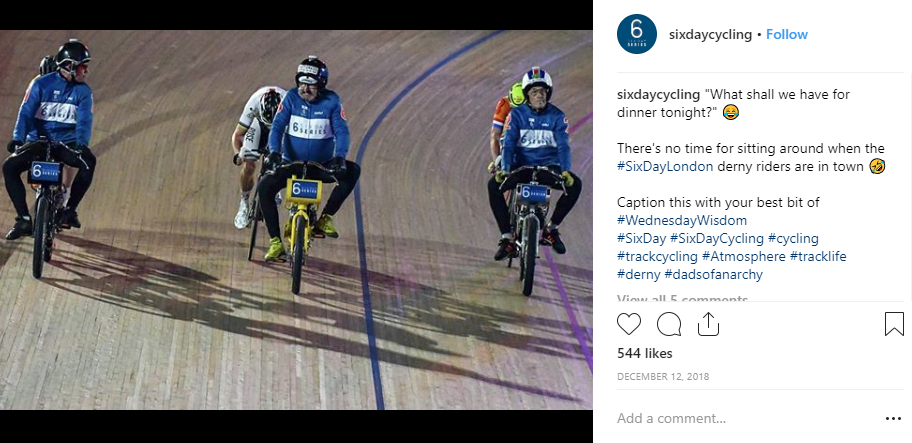The feeling as you drop in from the banking and hit the cote d’azur just perfectly to storm down the finish straight is one like no other. Sure, there are all sorts of rushes you can get on two wheels, but few come close to this one in terms of absolute, unadulterated speed and (hopefully) control.
For those not yet initiated into the ways of the boards, track cycling can seem like ‘just riding around in circles’ and that’s because track is an entirely different beast to other disciplines. Specialist ‘trackies’ like Laura Kenny, Chris Hoy and Elinor Barker choose to spend much of their track cycling lives flying around a banked wall of wood, rather than exploring the roads of faraway nations – something not immediately understandable to the outside eye. However, we can tell you the joy is not in the conquering of cols, but in the buzz and excitement of whizzing around a track as fast as you can, all the while trying not to crash.
Yes, the first time you try riding on a fixed-gear bike on a banked velodrome is going to be a little bit (ok, ‘a lot’) terrifying. Everyone who has done their track accreditation (the official British Cycling course that qualifies you to race) will tell you that those first few sessions are tough on the nerves – but once you get into the swing of it, you’ll find yourself rapidly addicted to the rush.
Not even the very best are immune to a bit of nerviness when getting back on the boards. Laura Kenny, multiple Olympic gold medallist, told Cycling Weekly she was a little uncertain when she made her track return after giving birth to her son at the end of last year.
“It took a bit of getting used to – I was a little bit shaky in the first two events in Milton and didn’t feel comfortable in the bunch, as there were a lot of riders who I didn’t know. But once I started the elimination race, I thought ‘actually, I can do this’, and I felt like myself again.”
Equipment
Track bicycles take you right back to the basics of riding with just one gear, a fixed wheel and no brakes. They’re designed to be super light but incredibly strong, with a very aggressive geometry that helps you to adopt the most aerodynamic position – with no gear levers or brakes to worry about, they are the very essence of efficiency.
They can be a little scary at first, but once you get used to how a fixed wheel works, you’ll be whizzing around the track in no time. In a nutshell, the rule is never, ever, ever stop pedalling. With no free hub, following your instinct and attempting to coast will only find you on the deck, a few layers of skin lighter. It’s up to your knees to resist the forward motion and slow yourself down.
Beyond the special bike, the top riders will wear aero helmets for some events and skinsuits are also de rigeur. Don’t be put off, however, you can ride track in bibs and a jersey – and the aero gains you get from a special lid are probably a bit more crucial in an Olympic omnium than at down your local Thursday night tear-up.

Sir Bradley Wiggins leads the Team Pursuit at the Track Cycling World Championships in 2016
Starting out
Not everywhere in the UK is blessed with a velodrome and for a lot of us, the nearest can be over an hour’s drive away. There are 28 in the UK, six of which are indoors: Calshot, Derby, Glasgow, London, Manchester and Newport. The Yellow Jersey team will always have a special place in our heart for Herne Hill, the outdoor velodrome built in 1891 and used for the London Olympics in 1948 – our director, Grant, chaired The Friends of Herne Hill Velodrome organisation for several years.
You’ll find that most velodromes offer bike hiring facilities, so you needn’t jump into the deep end and buy a track bike straight away. They should also offer a track accreditation training course, where you can learn how to ride safely around the banking alongside other riders. You’ll need to pass one of these if you want to start racing – and trust us when we say, after you try track, you’re definitely going to want to try racing!
What’s what?
But what kind of races can you participate in? If you’ve watched track at the Olympics or Commonwealth Games, you’ll have come across names like the Keirin, the Pursuit and the Omnium, but keeping the rules straight in your head is another matter.
https://www.instagram.com/p/Bpq4agll3vq/
There’s the Madison, where teams of two ‘handsling’ each other into action for a nifty speed boost and first made popular at Madison Square Garden in New York; there’s the keirin from Japan, which sees a motorbike pacer at the front of a pack of sprinters who unleash their efforts with just over two laps to go; there’s the points race, which assigns a given number of – you guessed it – points to the winners of specific laps; and there’s the pursuit, which is a mano-a-mano chase between two individuals.

This is just scratching the surface, of course, and there are many more events that have fallen out of Olympic fashion, or are unique to particular velodromes or nations. If you ever attended a Revolution Series event, you’ve probably witnessed the ‘longest lap’, where participants must track stand (stay stationary on their bike without putting a foot down) for an agonisingly long time, before contesting a one-lap sprint.
It’s best as a newbie not to get too fixated on these mini-disciplines, and instead focus on building up your confidence so you can roll the boards with a smile on your face, rather than a rictus grin of terror.
Preparation
Once you’ve got your accreditation and a few hours of track experience under your belt, you might want to set your eyes on some beginner’s races to really fuel your need for speed. There are one-off events throughout the year, but if you want to start racing regularly, we’d advise you join a track league – which mostly run through the winter.
All the information can be found at British Cycling, as can a load of other events, but in essence it works in a very similar way to crit racing, splitting riders into different categories based on their abilities and experience. Start flying through the lower leagues and you may just start to catch the eye of the British Cycling scouts that can be seen prowling the velodrome – this could be your calling!
Longer races like the scratch and point races require a lot of endurance and the ability to sprint every few minutes or so. For these events, HIIT (high intensity interval training) is the best choice, as well as long, endurance-building road rides. For the high-power sprint events, HIIT is another great training method, but you’ll also want to squeeze in a few gym sessions to work on your core and legs, increasing their overall power and strength.
Most amateurs (and many pros) do not spend their entire cycling lives on the boards. It’s totally normal to balance road riding in the summer with track sessions somewhere warm and dry during the colder months – back in the day, greats like Eddy Merckx made their living through winter by competing in six-day track competitions, and if it’s good enough for ‘the cannibal’…
The event
Joining a track league will give you loads of opportunities to compete, so it’s not so much a ‘one event’ sort of affair. Instead, you’ll keep getting out on the boards and pushing your lungs and limbs to their max – growing in confidence and track smarts as you go.
When you’re up there, the key is to keep it loose, be calm and don’t get perturbed by the occasional brush of an elbow from other riders as you battle for position in the bunch. Oh, and never, ever, ever stop pedalling.
You will be covered for track cycling worldwide with the Yellow Jersey Ultimate Bicycle Insurance policy.